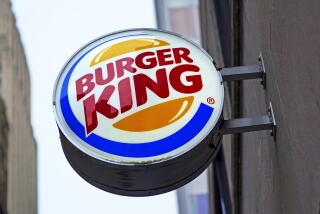Under the Influence? : Health: A new study links commercials to ‘more favorable beliefs about drinking’ among kids. Industry officials disagree.
- Share via
To millions of American adults, the cartoon-like “Bud Bowl” beer commercial during the Super Bowl was silly, funny or dumb--depending on your tastes.
But to a growing legion of health officials and educators, it was exactly what is wrong with government regulations on alcohol advertising. The commercials--especially those that use cartoons, sports themes or drop-dead gorgeous models--catch the eye of underage youths and may encourage them to drink, they charge.
That assertion is blasted by beer industry executives, who now are in a fierce showdown with health officials over the ads.
The battle will pivot on proposed federal legislation to affix health warnings on all radio and TV ads touting alcoholic beverages. Right now, health warnings are mandatory only on product labels.
“The intention is to provide a counterbalance to all the pro-drinking messages you see,” says Jeffrey Hon, a spokesman for the National Council on Alcoholism and Drug Dependence.
The bill, called the Sensible Advertising and Family Education Act (SAFE Act), is co-sponsored by the bipartisan team of Rep. Joseph Kennedy (D-Mass.) and Sen. Strom Thurmond (R-S.C.). Kennedy, who introduced the legislation in 1991, was joined in the effort last year by Thurmond, whose daughter was killed by a drunk driver.
But the bill has raised two key questions on alcohol use among underage drinkers:
* Do the current crop of beer ads persuade people under 21 to drink?
* Would health messages flashed on the screen at the end of a beer ad help curb underage drinking?
The answers to these questions are unknown, although almost everyone involved in the issue has an opinion.
Scientific studies are vague and contradictory. There is no proof that beer ads directly influence drinking. But a score of earlier studies showed that children as young as 10 retain information in these ads. And, in the strongest data yet on the subject, new research suggests that the ads are linked to “more favorable beliefs about drinking” among young children, which may predispose them to eventually drink.
The study, by California researchers, examined what fifth- and sixth-grade children thought about alcohol. The children who were more knowledgeable about beer ads also held more positive beliefs about drinking, researchers found. For example, children may have agreed with the statement: “Having a few beers is a good reward.”
The research, published in the February issue of the American Journal of Public Health, could not answer the question of whether the ads will eventually influence the children to drink, however, since most said they had not yet tried alcohol.
“It appears that advertising has an influence on their beliefs,” says Joel Grube of the Prevention Research Center in Berkeley and a co-author of the study. “But the missing piece is the effects that this may have on behavior. At this point in time, we just don’t know.”
While Grube said he was surprised by the strong link between the ads and what kids think about alcohol, he points out that most studies show it is peer pressure that usually leads them to drink.
“The peers are the most important influence in terms of kids’ behavior. But the advertising is one more thing that needs to be considered,” he says.
The study is significant because it shows that even 11-year-olds are familiar with beer ads and have developed attitudes about drinking, says James Mosher of the Marin Institute for the Prevention of Alcohol and Other Drug Problems in San Rafael.
“The study is powerful because the beer industry is saying that they are only targeting those 21 years and older. We are talking about impacting a group that clearly should not be impacted.”
But the study is no proof that ads lead underage people to drink, says Stephen K. Lambright, vice president of Anheuser-Busch Cos. in St. Louis.
“While we disagree broadly with the study, it did not even claim to say that alcohol advertising causes young people to drink. It stated that young people who saw ads were more likely to drink as adults, not as teens,” he says.
Moreover, alcohol industry leaders reject the notion that health messages will do any good.
“We reject the SAFE bill in its entirety and the underlying premise that alcohol advertising leads to alcohol use or underage drinking. That has never been proven in a single study,” says Ray McGrath, president of the Beer Institute, an industry group representing the nation’s largest brewers. “Advertising has nothing to do with trying to get people to drink. It’s strictly a function of trying to create a market.”
*
In recent years, the industry has drawn widespread criticism for altering beer ads from traditional images, such as horse-drawn carriages and simple pictures of the product, to race-car driving, beach volleyball and “happy hour”--all scenes that appeal to young people.
Another study co-authored by Grube in the current American Journal of Public Health analyzed commercials for alcoholic beverages shown during 443 hours of televised sporting events. It found 15% featured celebrities, such as athletes; 16% contained images of cars or other motor vehicles, and 26% showed water activities.
“They are not selling beer; they are selling a lifestyle. That’s why it appeals to kids: It appeals to a certain lifestyle,” says George Hacker of the Center for Science in the Public Interest, a nonprofit consumer group that supports the SAFE Act.
“Advertising establishes beer as associated with wonderful things, instead of any of the downsides, like drinking-and-driving crashes,” he says. “The ads paint a one-sided picture of this product.”
The emphasis on young, glamorous fun-seekers in beer ads has already led to several protests.
The cities of Huntington Beach and Laguna Beach have rescinded permits for Women’s Professional Volleyball Assn. tournaments to be held on the beach because the contests are sponsored by brewers who advertise at the events with large banners. And doctors’ groups in Washington state have fought for laws to outlaw liquor ads that appeal to young people.
The wine industry has escaped some of the criticism directed at brewers because most of its commercials are targeted at older people, says Hon of the National Council on Alcoholism and Drug Dependence.
The exception, however, is wine coolers, which are favored by younger people.
*
Beer industry leaders point to the decline in drinking-and-driving auto crashes among youth as evidence that kids are already being dissuaded from drinking before age 21.
Surveys show modest drops in alcohol use among school-aged children in the past decade. But 69% of eighth-graders and 87% of 12th-graders still say they have used alcohol. And according to a study by former U.S. Surgeon General Antonia Novello, an ardent critic of alcohol advertising, alcohol is still a leading cause of accidents among youths.
The nation’s brewers, however, cite their “moderation messages”--such as “Know when to say when” and “Think before you drink”--as proof of their good intentions.
“There is probably no industry that does more and spends more to dissuade people from abusing their product,” McGrath says. “We have spent millions on moderation messages and we contribute money to programs to educate kids. We think that is the correct way of going, and it has already produced results. Every indicator of alcohol abuse among teens, including fatalities for driving drunk, has gone down. So we question the need for (the proposed legislation).”
But health advocates say that the moderation messages don’t work and that too many underage youths still drink.
“Moderation messages tend to portray the advertisers as good guys without really doing anything concrete to help,” Hon says. “ ‘Know when to say when’ is an empty phrase. The information is there for the alcoholic beverage industry if they were sincere. For example, they never define moderate levels of consumption in a manner that is useful for the public.”
Most health experts say a moderate level of drinking is one drink for a woman and two drinks for a man per day. In addition, abstinence is suggested for people under age 21, pregnant women, people who plan to drive or who are using medications.
*
But whether printed messages such as “Alcohol is a drug and may be addictive” flashed on the screen at the end of a beer commercial would help reduce underage drinking and alcohol abuse is also hotly debated.
Health experts already disagree on whether the warning labels on alcohol beverages have any effect on kids.
“Awareness of that label doesn’t seem related to their attitudes and their beliefs,” says Grube of his recent study. “I’m not an enthusiastic supporter of the advertising warnings. But it might be a small step.”
Others say the SAFE Act would be a small, but significant, step.
“Alone, it’s going to be difficult to measure the impact,” says Hacker of the Center for Science in the Public Interest. “But over time, this would be the foundation of other information and prevention activities that are focused on reducing underage drinking.”
The messages would move beyond most public-service announcements that warn against drinking and driving.
“You see very little on alcohol poisoning or Fetal Alcohol Syndrome or the association between alcohol and other drugs,” Hacker says. “We would be able to broaden the message. And by hooking ourselves to the ad, we could reach the mass audience exposed to beer ads.”
The messages that would be flashed on the screen, however, are too simple and vague to do much good, McGrath says. For example, one message points out that it is illegal for anyone under age 21 to purchase alcoholic beverages.
“Everyone in the world knows that,” McGrath says. “Surveys show there is between a 95% and 100% awareness of that fact. So why do you need it if there is this super saturation of awareness?”
What everyone seems to agree on is that the problem of underage drinking still rests heavily with parents, in addition to schools and medical professionals.
Possibly one of the best tactics to reach kids, Hon says, is for parents to watch television with their children and talk to them about the ads and about drinking when a beer commercial comes on.
“That is what we call a ‘teachable moment.’ Parents can talk to kids about how the product is being sold. And there are certainly lots of opportunities for parents to do that,” he says.
Proposed Warnings for Ads
The Sensible Advertising and Family Education Act would require a series of seven rotating health and safety messages in TV and radio advertising for alcoholic beverages. The proposed Surgeon General’s warnings:
* If you are pregnant, don’t drink alcohol. Alcohol may cause mental retardation and other birth defects.
* If you are under 21, it’s illegal to buy alcoholic beverages.
* Alcohol is a drug and may be addictive.
* Don’t drink and drive or operate heavy machinery.
* Don’t mix alcohol with medications and other drugs.
* Alcohol poisoning can kill you. Don’t drink too much too fast.
* Drinking increases your risk of high blood pressure, liver disease and cancer.






